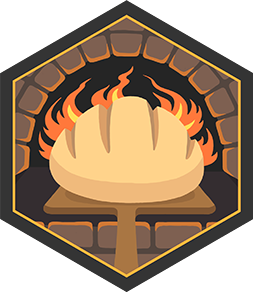Bake a loaf
Make a simple loaf of bread by mixing, kneading, shaping dough, and baking with adult supervision to learn measurements, yeast, and patience.



Step-by-step guide to bake a loaf of bread
Your BREAD Always Comes Out Perfect! Every Single Time. Easy for beginners.
Step 1
Gather all your materials and measure the ingredients on the counter so everything is ready.
Step 2
Pour about 1 cup of warm water into the mixing bowl.
Step 3
Add 2 teaspoons sugar and 2 1/4 teaspoons instant yeast to the warm water.
Step 4
Stir the yeast mixture gently for 10 seconds until the sugar starts to dissolve.
Step 5
Let the bowl sit for 5 to 10 minutes until the yeast mixture looks foamy on top.
Step 6
Add 2 tablespoons oil 1 teaspoon salt and 2 cups of flour to the bowl and stir until a shaggy dough forms.
Step 7
Add more flour 1 tablespoon at a time while stirring until the dough comes together and is not too sticky.
Step 8
Turn the dough onto a lightly floured surface.
Step 9
Knead the dough for 8 to 10 minutes until it becomes smooth and elastic.
Step 10
Place the dough into a lightly oiled bowl and cover it with the kitchen towel.
Step 11
Let the dough rise in the bowl until it has doubled in size about 1 hour.
Step 12
Gently punch down the dough to release the air.
Step 13
Shape the dough into a loaf and place it into the greased loaf pan.
Step 14
With an adult’s help preheat the oven to 375°F and bake the loaf for 25 to 30 minutes until it is golden and sounds hollow when tapped.
Step 15
Share a photo or description of your finished loaf on DIY.org
Final steps
You're almost there! Complete all the steps, bring your creation to life, post it, and conquer the challenge!


Help!?
What can we substitute if we don't have instant yeast, a greased loaf pan, or a kitchen towel?
If you don't have instant yeast, dissolve active dry yeast in the 1 cup of warm water and proof it for 10–15 minutes before adding flour; if you lack a greased loaf pan, shape the dough into a loaf and bake on a lightly greased baking sheet; and if you don't have a kitchen towel, cover the bowl with lightly oiled plastic wrap during the rise.
My yeast mixture didn't look foamy after 10 minutes or the dough stays very sticky—what should we do?
If the yeast mixture isn't foamy after 5–10 minutes, your water was probably too hot or cold so redo it with water about 105–110°F and fresh yeast, and if the dough remains sticky after adding flour tablespoon by tablespoon, dust the surface and your hands with flour and knead a few extra minutes until smooth and elastic as directed in the knead step.
How can we adapt this recipe for younger children or older kids to make it safe and engaging?
For younger children let them help measure and stir the ingredients in steps 1–6 while an adult handles the yeast activation, kneading, rising, and oven work, and for older kids let them practice kneading for the full 8–10 minutes, shaping the loaf, and with supervision preheating to 375°F and timing the 25–30 minute bake.
What are some simple ways to personalize or improve our loaf before baking or for sharing on DIY.org?
To personalize the loaf, fold in mix-ins like 1/2 cup shredded cheese, chopped herbs, or seeds during the 'shaggy dough' step, brush the top with oil or milk before baking at 375°F for a shinier crust, and score or sprinkle seeds so your finished loaf looks great for the DIY.org photo.
Watch videos on how to bake a loaf of bread
Easy Homemade Bread for Beginners, 100% NEVER FAIL Bread Recipe, Who Love Fresh Loaves !
Facts about baking for kids
⏳ A slow, cool rise (long fermentation) can make bread more flavorful than a quick rise.
⚖️ Professional bakers often weigh ingredients — weighing flour gives more consistent loaves than using cup measurements.
🍞 Baking yeast (Saccharomyces cerevisiae) is a single-celled fungus; a teaspoon contains millions of cells that eat sugar and puff up dough.
🥖 Humans have been making bread-like foods for at least 14,000 years — older than farming!
🤲 Kneading stretches gluten strands in dough, which trap gas and make bread chewy and airy.
How do you make a simple loaf of bread with a child?
What materials and ingredients do I need to bake a simple loaf with a child?
What ages is this baking activity suitable for?
What are the benefits and safety tips for baking a loaf with a child?


One subscription, many ways to play and learn.
Only $6.99 after trial. No credit card required



